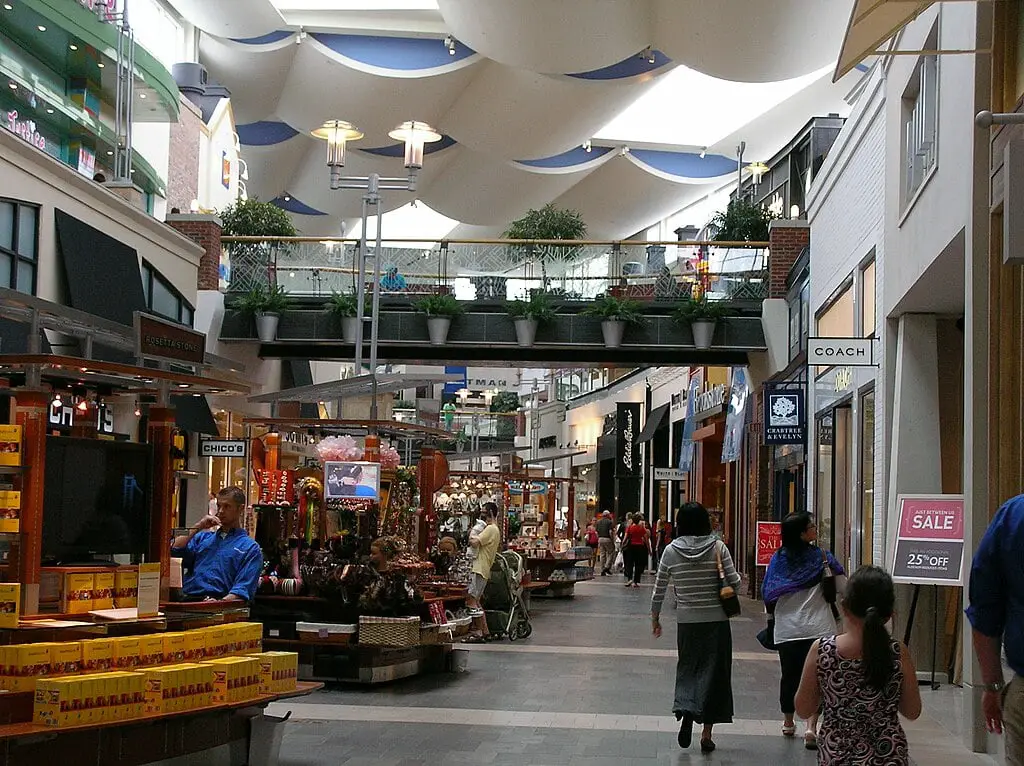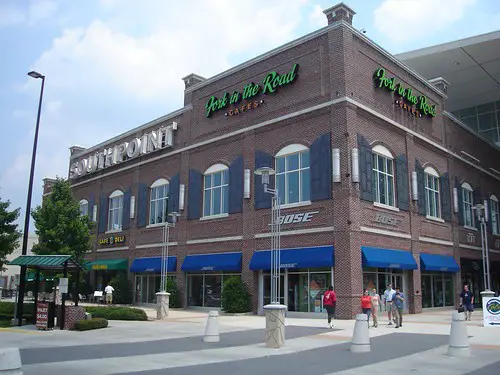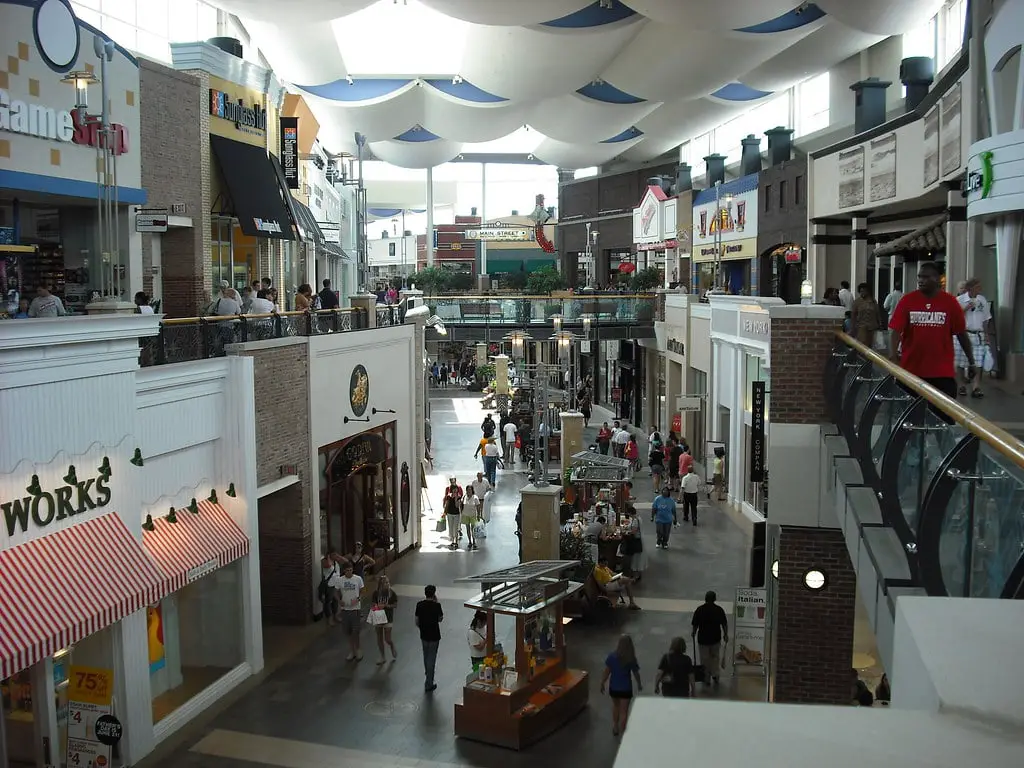The Streets at Southpoint Mall: A Historical Perspective
The Streets at Southpoint emerged from the ground up, transforming a piece of Durham, North Carolina, into a bustling hub of commerce and social life. I imagine the anticipation that rippled through the city as March 8, 2002, approached.
This wasn’t just another mall opening; it was the culmination of over six years of planning and construction, a significant investment by Urban Retail Properties aimed at reshaping the retail landscape of the Research Triangle.
The opening was a landmark event, drawing 300,000 visitors in the first three days alone. It was a testament to the hunger for such a space in Durham, a city that had not seen a new mall in nearly three decades.
The Streets at Southpoint was more than a collection of stores; it was a destination, introducing residents to brands and experiences previously unavailable in the area.
The arrival of North Carolina’s first Nordstrom and Apple Store, alongside other firsts like Aveda and California Pizza Kitchen, marked a new era in local retail.
The mall’s impact extended beyond consumerism. It represented a shift in Durham’s economic and cultural narrative, offering a new community engagement and entertainment venue.
The developers, Urban Retail Properties, crafted an experience that resonated with the residents and positioned Durham as a burgeoning center for shopping and leisure in North Carolina.
Reflecting on those early days, it’s clear that The Streets at Southpoint was a bold venture, a leap of faith in the city’s growth and potential. It set the stage for what has become one of the most visited retail destinations in the region.
For anyone looking for things to do in Durham, North Carolina, the mall remains a testament to the city’s evolution, a symbol of progress, and a beacon of modernity in a town rich with history and tradition.
Architectural Marvels and Design
The Streets at Southpoint stands out for its unique design. The architects, RTKL Associates, chose a hybrid model combining the best indoor comfort with the charm of outdoor shopping.
This design choice speaks volumes about the mall’s ambition to offer a diverse shopping experience. Using over 2 million red bricks ties the structure to Durham’s historical aesthetic and gives it a distinctive, timeless look.
The 70-foot glass wall that divides the indoor and outdoor sections is nothing short of architectural brilliance. It blurs the line between the natural and commercial worlds, allowing sunlight to pour into the space.
At the same time, shoppers enjoy the best of both worlds. The outdoor section, designed like a Main Street, brings a sense of community and openness, setting it apart from traditional malls’ enclosed, often claustrophobic feel.
The mall’s attention to detail extends to the interior. Handrails feature maps of Durham, connecting shoppers to the city even as they navigate through the latest fashion stores.
The food court, dubbed “Fork in the Road,” takes inspiration from Durham’s old tobacco warehouses, blending history with modernity.
This thoughtful design fosters a connection between the mall and the city’s heritage, making shopping an experience rather than just a task.

Evolving Retail Landscape
Since its opening, The Streets at Southpoint has seen significant changes in its retail lineup. The departure of Sears in 2019 was a considerable shift, reflecting the changing tides of retail.
However, the mall has filled with trendier, more contemporary brands. The introduction of Peloton, Warby Parker, and Offline by Aerie in recent years marks a shift towards lifestyle and wellness-oriented retail catering to the evolving demands of Durham’s diverse population.
The expansion of the Apple store is particularly noteworthy. In an era where technology is king, this move signifies the mall’s commitment to staying relevant and catering to the tech-savvy consumer.
This adaptability is crucial in the fast-paced world of retail, where staying static means falling behind.
The Streets at Southpoint has not just adapted to changing retail trends; it has anticipated them. By diversifying its store portfolio and embracing new retail formats, the mall continues to attract a wide range of shoppers.
This forward-thinking approach ensures that The Streets at Southpoint remains a key player in the competitive retail landscape, adapting to the needs and wants of its customers while staying true to its roots.
Anchors of The Streets at Southpoint: Retail Giants and Entertainment Hubs
JCPenney
JCPenney has been a staple at The Streets at Southpoint since the mall’s inception in 2002. As one of the original anchors, it has weathered the retail storms and shifts in consumer behavior.
Known for its wide range of family apparel, home furnishings, and beauty products, JCPenney at Southpoint has adapted and incorporated more brands and services to cater to a diverse clientele.
Despite the ups and downs the chain faces nationally, the Southpoint location remains a go-to for many Durham shoppers, reflecting the community’s loyalty and the store’s ability to stay relevant.

Macy’s
Macy’s, another cornerstone of The Streets at Southpoint, replaced Hecht’s in 2006, bringing a rich history of department store retailing.
Macy’s has become synonymous with fashion, luxury brands, and the annual Thanksgiving Day Parade. At Southpoint, Macy’s offers a wide selection of clothing, accessories, home goods, and cosmetics, catering to upscale shoppers.
The store has managed to maintain its allure by hosting events, offering personalized shopping experiences, and adapting to the digital age with an omnichannel approach.
Nordstrom
Nordstrom, known for its exceptional customer service and high-end products, has been part of The Streets at Southpoint since the beginning.
It was the first Nordstrom in North Carolina, marking a significant expansion for the Seattle-based company. The store has become a destination for fashion-forward shoppers, offering a range of designer brands, luxury beauty products, and exclusive services like personal stylists and tailoring.
Despite luxury retailers’ challenges, Nordstrom at Southpoint continues to thrive, partly thanks to its commitment to customer satisfaction and quality.
Belk
Belk, a regional department store chain, has deep roots in the South and has been a key player at The Streets at Southpoint since the mall opened.
Catering to families and traditional shoppers, Belk offers a variety of apparel, shoes, accessories, and home goods.
The store prides itself on its southern hospitality and community involvement, often participating in local events and charities.
Over the years, Belk at Southpoint has adapted to changing market dynamics by refreshing its brand offerings and enhancing its in-store experience.

AMC Theatres
AMC Theatres, a leading entertainment destination at The Streets at Southpoint, provides a state-of-the-art cinematic experience.
With multiple screens, including an IMAX theatre, AMC offers diverse film selections, from blockbuster hits to indie favorites.
Since its opening in 2013, the theatre has become a popular spot for moviegoers, offering comfortable seating, advanced sound and projection, and a variety of concessions.
The AMC at Southpoint reflects the evolving landscape of movie-watching, incorporating the latest technology and amenities to enhance the viewer’s experience.
Safety and Security Measures
Safety has become a paramount concern for The Streets at Southpoint, especially following the unsettling events of Black Friday 2021.
The introduction of a firearm-detecting canine is a step towards enhancing security. It responds to past incidents and a growing need for safer public spaces. This move has sparked a mix of reactions – relief, curiosity, and even skepticism.
But safety measures extend beyond the presence of a security dog. The mall has ramped up its security protocols, reflecting a growing trend in public space management.
The balance between creating an open, welcoming environment and ensuring the safety of visitors is delicate. As someone who values freedom and security, I watch these developments closely, hopeful yet cautious.
The challenge for The Streets at Southpoint lies in maintaining the delicate balance between accessibility and security.
As the mall evolves, so must its approach to keeping shoppers safe. This never-ending task is crucial for the mall’s future.

Transforming The Streets at Southpoint: A New Era for Durham, NC
The Streets at Southpoint in Durham, NC, is embarking on a transformative journey. The Durham City Council recently approved a significant rezoning request in a 5-2 vote, paving the way for a future far beyond traditional retail.
The mall, a staple of the Triangle area and a beacon for 13 million annual visitors is set to evolve into a mixed-use development.
This new chapter involves constructing over 1,300 apartments, adding 100,000 square feet of retail and restaurant space, and developing 300,000 square feet of office areas alongside up to 200 hotel rooms.
This ambitious plan by Brookfield Properties aims to adapt to changing shopping habits and ensure the mall’s relevance and success in the coming decades.
The decision reflects a broader trend affecting large malls nationwide as they seek new ways to attract visitors and remain central to their communities.
The future looks bright but challenging. With competitors like Fenton and Raleigh Iron Works entering the scene, the mall’s ability to adapt and innovate will be crucial.
These developments are not just about expanding physical space; they’re about reimagining what a mall can be in the 21st century.
However, this expansion has sparked conversations, especially since it doesn’t include affordable housing. It’s a complex issue.
On one hand, the development promises to bring more business and vibrancy to the area. On the other, it raises questions about inclusivity and community benefits.
Despite this, the mall’s commitment includes a $1 million contribution to Durham’s affordable housing fund and enhancements to local infrastructure, such as additional bus stops and bike lanes.
As someone who keeps an eye on urban development, I see this as a pivotal moment for The Streets at Southpoint and Durham.
I see this development as a significant shift for Durham, balancing the excitement of growth with the challenges of ensuring it benefits the entire community.
The Streets at Southpoint’s transition from a traditional mall to a mixed-use hub could redefine southern Durham, blending retail with residential and commercial spaces to reflect the city’s dynamic spirit.
